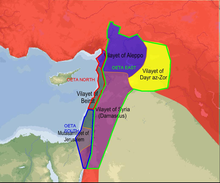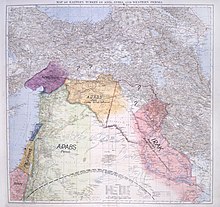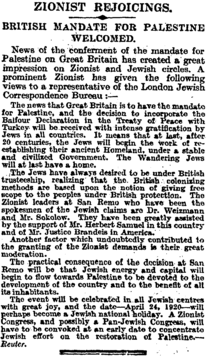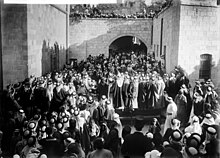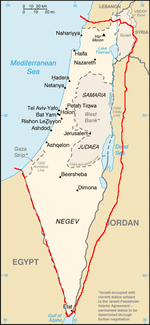
האלוף במיל. יואב גלנט, האיש שכמעט והפך לרמטכ"ל, חושף תחזית קודרת על מצבה של ישראל בעתיד הקרוב: "שמורת הטבע של העם היהודי מאבדת את צביונה. בעוד 15 שנה ישראל תאבד את הרוב היהודי לטובת ערבים, תיאלדנים וסודנים" על סוריה: " אסד סיים את תפקידו ויחל עידן הסונים... וחיזבאללה עם 50 אלף טילים נכנס לפינה" על ירדן: "אחרי עידן אסד - הבלגן יעבור לשם" על מצרים: "סיכוי גדול שניכנס עימם לעימות צבאי"
▪ ▪ ▪
"אם לא תהיה הפתעה מיוחדת, אז בעוד 15 שנה יהיו ממערב לשבר הסורי אפריקני 8 מיליון יהודים ו-8 מיליון לא יהודים, שזה בעיקר ערבים וגם קצת תיאלנדים, סודנים ואחרים" - כך אמר האלוף במיל. יואב גלנט, שכמעט מונה לרמטכ"ל ומינויו בוטל בעקבות פרשת הקרקעות, בדברים שנאמרו בשיחות סגורות בפני מספר סטודנטים צעירים, בוגרי מלגת אימפקט, בתל אביב. הדברים נחשפו על-ידי עיתון "מקור ראשון" וכתבו ישי פרידמן.
"אני אומר 'הפתעה', במובן שיש לנו את היכולת אחת לעשור, או דור, למצוא איזה שבט נידח - פעם זה ברוסיה ופעם זה באתיופיה ופעם במקום אחר אבל זה פחות או יותר הולך ומתמצה".
"מדינת ישראל הוקמה כלקח של העם היהודי שאומר, בגדול: חיינו אלפיים שנה בגלות. נתנו לעולם את התנ"ך, את שפינוזה, איינשטיין, את הרמב"ם וגם את ברברה סטרייטנד וקיבלנו בתמורה רדיפות, פוגרומים, אינקוויזיציה ובסוף שואה והפתרון היחיד הוא שלעם הנכחד הזה יהיה מקום להניח בו את הראש ולשים את הרגליים ובו הוא יכול להגן על עצמו בכוחות עצמו. במובן הזה הוקמה פה שמורת טבע שבה יהודים יוכלו להגן על עצמם בכוחות עצמם. שמורת הטבע הזו למעשה הולכת ומקבלת צביון שונה. עכשיו, האם יהיו פה בסוף יותר לא יהודים מיהודים ולאן זה יילך, אינני יודע אבל הנושא הזה צריך לקחת אותו בחשבון על כל המשמעויות. אומנם זו לא עובדה, אבל זה הכי קרוב לעובדה כתחזית סטטיסטית".
בהתייחסו לתהפוכות בעולם הערבי, אמר גלנט כי מדובר בשינוי שלא היה כדוגמתו, וכי כוונתו לכך שכל השליטים באזור התבססו על צבא וכוחות ביטחון כמקור הכוח שלהם וביסודו של דבר הם היו דתיים לכאורה וחילונים למעשה, והם התבססו על כוחות צבא קודם כל כדי להשליט את השלטון שלהם על העם שלהם בראש ובראשונה. "בשנת 1920 אחד בשם אל באנה מקים ארגון בשם האחים המוסלמים במצרים. במקביל קם ארגון דומה בפקיסטן והם יושבים על הקווים ומחכים להיכנס למשחק במשך שמונים, תשעים שנה, מחכים להיכנס למשחק ובפעם הראשונה שהם נכנסים למשחק היא במהפכה שמתחוללת בעזה בתמיכה אמריקנית ובהסכמה ישראלית כשהחמאס לוקח את השלטון בבחירות, ואחד שקורא מודיעין כמוני מסתכל מה כתוב ושואלים את חמאס מודע אתם הולכים לבחירות והם עונים משהו בסגנון 'אין לנו ברירה אלא להשתמש בשיטה שהמציאו הכלבים הציוניים והאמריקנים שנקראת דמוקרטיה'. זה מה שנקרא מסמר בלי ראש הכנסת אותו פעם אחת .. בואו נראה מתי יהיו הבחירות הבאות בעזה לדעתי אנחנו נחכה זמן".
גלנט טוען כי המוסלמים מנצלים את הדמוקרטיה בחסות האמריקנית כדי להרחיב את השליטה. "הרעיון האמריקני הוא רעיון נפלא אבל הוא לא מתאים בעת הזאת למקום הזה. מה שאתם שומעים ממני", אמר גלנט לסטודנטים, "שמעו גם אחרים - מקולין פאואל דרך קונדוליזה רייס עד יו"ר המטות המשולבים, תלוי באיזה תפקיד הייתי. מה שקרה בפועל במזרח התיכון זה למעשה העברת הכוח ובסיס הכוח של שלטון שנשען על ארגונים צבאיים ועל ארגוני ביטחון לשליטה של ארגון מפלגתי מוסלמי הבסיסי וכל מה שיש מאחוריו זה לא קרה במקום אחד. זה קרה באירן שהיא שיעית לפני שלושים שנה, קרה בעזה. בשלבים הבאים זה מה שקורה בצפון אפריקה באלג'יריה ובחלקים מסוימים בחצי האי ערב, תימן ומצרים כמובן שזה דבר שמאוד צריך להטריד אותנו והעניין הזה לטעמי אינו מבשר טובות עבורנו".
"אסד הוא השליט העלוואי האחרון בעת הזאת"
לגבי סוריה דעותיו של גלנט נחרצות ביותר: "אסד ועדת העלוואים סיימו את תפקידם בהנהגת המדינה הסורית. העתיד שייך לסונים. בשאר אל אסד עוד לא הגיע לכמות ההרוגים שאביו חאפז אל אסד הרג בחודש או בשבוע. אם היום בדמשק יש מרידה של סונים נגד בשאר אל אסד זה אחרי שיש להם זכרון היסטורי של עשרות אלפי הרוגים המשמעות היא שהעניין הזה עבר את הסף שאפשר לשלוט עליו. אני בניגוד לאחרים לא מתכוון להתנבא מתי תהיה החלפת שלטון אבל אני יכול לומר דבר אחד: באשר אל אסד הוא השליט העלוואי האחרון בעת הזאת. השליט הבא יהיה סוני", קובע גלנט.
"לתוך סוריה", אומר גלנט, "נכנסו גורמים איסלמיים סונים קיצוניים והם משנים את המאזן לטובת המוסלמים הסונים. בוואקום שנוצר בתוך סוריה מי שנכנס אלו הקבוצות המאורגנות אל קעידא, ג'יהאד עולמי, זה חמאס והאחים המוסלמים הם תופסים מאחז בקרב הסונים ומי שחושב שאי-אפשר לעשות את זה בסוריה שיסתכל מה קורה בסיני ואפילו מה קורה בנגב בישראל. אוכלוסיה בדואית שאף פעם לא היה שום קשר לדת מתחברת. אתה מסתכל היום בתמונת לווין על סיני הרבה מאוד מסגדים. תסתכלו על רהט... אני זוכר את רהט לפני 40 שנה. לא היה מסגד אחד. היום אתה עובר ברהט, אתה לא יכול להבדיל בין רהט לאום אל פאחם מבחינת כמות המסגדים. הדבר הזה צריך להדאיג מבחינתנו".
באופן טבעי, סבור האלוף במיל., מה שמתחולל בסוריה עתיד להשפיע באופן דרמטי על ירדן ולבנון. "בלבנון יש ארבע קבוצות בסיסיות חזקות: שיעים, סונים, דרוזים ונוצרים", הסביר גלנט. "השליטה וההגמוניה של השנים האחרונות עוברת באופן משמעותי לידי השיעים כתוצאה מהתמיכה האירנית ומאותה קשת של טהרן-דמשק-ביירות. אבל השחקנים בלבנון מסתכלים על מה שקורה בסוריה ורואים ששלטון העוולאים הולך ליפול הסונים הולכים לעלות. אם כך, הדבר הזה ישפיע על מה שקורה בלבנון והם מחכים. חיזבאללה נכנס לפינה. אבל כשחיזבאללה בפינה זה דבר אחד וזה דבר אחר כשחיזבאללה עם 50 אלף טילים נכנס לפינה. מה הוא יעשה אני לא יודע. אבל תזכרו יש בסך הכול מיליון שיעים, אלפי לוחמים, בסוף יש מסביבם קואליציה שהולכת ומתגבשת של דרוזים, נוצרים וסונים שלא אוהבים את ההגמוניה של החבר'ה האלה. אני מעריך שהדבר הזה יהיה מאוד רגיש על-רקע מה שקורה בסוריה".
"אחרי סוריה - ההפיכה תעבור לירדן"
לדברי גלנט, גם בירדן עוקבים בדריכות אחר הנעשה בסוריה. לדעת גלנט, ביום שאסד יפול כל העיניים יופנו לירדן. "חוץ מארה"ב", אומר גלנט על ירדן, "זו מדינה שהיא בשורה הראשונה של בעלות הברית שלנו אבל היא אוהבת את ישראל כפילגש ולא כאישה חוקית. היא מוכנה שהקשרים הללו ימשכו ובלבד שהם יהיו מתחת לשולחן אסור לדבר עליהם כי כלפי חוץ צריך להראות משהו אחר. ישראל מסייעת לביטחון הירדני, ירדן מסייעת לביטחון הישראלי. 500 ק"מ של גבול הארוך ביותר שלנו שקטים לחלוטין. למה? יש אינטרס משותף בין השושלת ההאשמית לבין הציונות ומדינת ישראל שהפלשתינים יישבו בשקט כל אחד מהסיבות שלו וזה עובד אבל זה מאוד לא פשוט. יש היום כחצי מיליון פליטים בתוך ירדן, חצי מעירק וחצי מסוריה, וזה הולך ומתרבה כל יום. החבר'ה האלה פרובוקטיביים קשה מאוד לחיות איתם. זו מציאות לא קלה. אני הייתי מגדיר את זה ככה: אם אתם שומעים יום בהיר אחד שאסד נפל, תתחילו להסתכל מה קורה בירדן. זה לא מובן מאליו שירדן תשרוד את כל הדברים האלה. ומי שמסתכל מזרחה יודע שאחר רבת עמון יש את בגדד ואחרי יש את טהרן ואין באמצע שום ידיד אמיתי ליותר מאלף ק"מ. אותי זה מטריד", הוא פוסק.
"השלום לא קיים. נמצא עצמנו שוב בעימות עם המצרים"
גלנט לא פסח על המהפכה במצרים בדבריו, ואמר כי "קרה משהו מאוד דרמטי במדינה ברגע שהאחים המוסלמים לקחו את השלטון. "יש רובד של אוכלוסיה מאוד קיצונית בתוך מצרים. אנשים שבשבילם ישראל זה דבר שצריך להיעלם מהמפה", אמר גלנט וסיפר: "כשהייתי המזכיר של שרון והייתי מגיע לשגרירות במצרים ושם הייתי פוגש את ידידנו עומר סולימן, אללה ירחמו, וישבתי איתו והסתכלתי על הקיר שממול שם יש לוח מודעות בגודל של עשרה מטרים ומראים בו חמישה ראשי ממשלות לשעבר במין קריקטורה כזאת שהם אוכלים ילדים פלשתינים והדם שלהם נוזל על הקרטון, וכשאתה אומר לעומר סולימן למה אתם מאפשרים את הדבר הזה? הוא היה אומר 'זו מדינה דמוקרטית. כל אחד עושה מה שהוא רוצה. העיתונות כותבת. זה מפרסם על לוח מודעות. אין לנו מה לעשות נגד זה'".
"ואני אומר את זה בצורה הכי בוטה והכי קשה. חוץ מתעמולת הזוועות של גבלס במלחמת העולם ולפניה", קובע גלנט, "אין תעמולה קיצונית וארסית נגד מדינת ישראל יותר מאשר התמונות בעיתונות המצרית. אני מציע לכם להיכנס לאינטרנט ולראות איך הדבר הזה נראה. על בסיס השנאה הזאת אני יכול לומר, לצערי, כשמסתכלים על השנה-שנתיים האחרונות, אנחנו הגענו אחרי שלושים שנה של שלום בחזרה למצב של שביתת נשק. אין מלחמה, אבל זה לא בדיוק שלום. אני לא חושב שמצרים רוצה להילחם בישראל, אבל מלחמות נוצרות לפעמים בדרך אחרת, לא כתוצאה של רצון של מנהיג או שליט. אם פעם האחים המוסלמים ישבו בעמדה מאוד נוחה בעמדת הווטו ומובארק עשה משהו, הם אמרו 'לא בסדר'. היום זה אחרת. הם אחראים. בפעם הבאה שיהיו מהומות-לחם, מה יהיה? כבר אי-אפשר יהיה להאשים את מובארק. עכשיו, מה בדרך כלל קרה בעולם במשך מאות שנים במצבים כאלה? שנאת הזר. יסבירו להם: הציונים לקחו לכם את האוכל, גנבו את מדבר סיני. לא משנה, איזה סיפור שאתם רוצים... הם בכלל מאיימים על מוחמד והם מפיצים עליו קריקטורות ואני יכול לספר לכם... תקראו פעם על הסיפורים של המצרים, שהם מאמינים בהם שהסוכנות של המוסד מפיצה איידס ועד מה שאתם רוצים, סיפורים לא הגיוניים. אבל בלתי הגיוניים זה דבר אחד ושמונים אחוז מהאוכלוסיה שמאמינה בזה זה דבר אחר, ואין לנו ברירה כמצרים אלא להכניס דוויזיה אחת או שתיים לסיני והתהליכים מתחילים לזרום. אני לא חושב שלמצרים יש עניין לעשות מלחמה אבל אני חושב שהסיכוי שכתוצאה מבעיות פנים אנחנו נמצא את עצמינו במתיחות הולכת וגדלה עם מצרים, הוא סיכוי מאוד טוב ומאוד מדאיג".
פורסם ב יוני 2004


